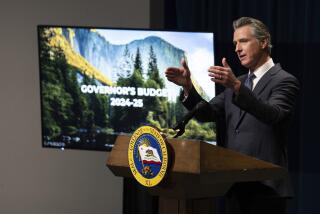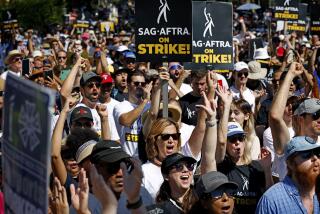What happens to the U.S. economy if the $600 federal unemployment benefit ends?

- Share via
WASHINGTON — When the COVID-19 pandemic first drove the country into lockdown and tens of millions of workers lost their jobs, Congress voted to add $600 a week to whatever individual states paid in unemployment insurance.
That extra money was a desperately needed lifeline for many because state unemployment benefits typically replace less than half a worker’s paycheck. Adding the federal payment on top gave many low-income workers more than they earned before.
Now with the $600 boost about to end, Congress must decide whether to let it die, continue it or cut back the payment levels. Recent negotiations suggest lawmakers on both sides are open to extending only a reduced or more restrictive version of the payment.
Most Republicans argue that the present system encourages workers to remain on unemployment rather than go back to work. Ending or slashing the federal payments would help employers and investors by pressuring many of those employees to return to work.
But maintaining the extra unemployment payments at or near present levels would help millions of workers keep paying their rent, writing mortgage checks, making car payments and caring for families. That’s especially true right now, when the pandemic is getting worse in many parts of the country and local officials are moving to restore lockdown rules they had begun to relax when the danger seemed to be fading.
In addition to helping the jobless, keeping the extra payments at or relatively near the current level would provide a substantial boost to an economy still reeling from the effects of COVID-19. Conversely, abolishing or slashing the federal payments would undercut the economy.
Basic unemployment insurance payments are determined by each state. During the first quarter of this year, they averaged $373 a week. The additional $600 a week was part of Congress’s $2.2-trillion relief package known as the CARES Act and passed in March.
Beyond anecdotal reports of employers struggling to recall workers, one of the few attempts to measure the extent of the problem was a May 18 survey by the National Federation of Independent Business, a small-employer lobbying group. It reported that 18% of 685 respondents said an employee had declined a job offer in order to stay on unemployment benefits.
“Even in the best situation, hiring is often a difficult process. But when there’s competition with a government program, it’s even more challenging,” said Holly Wade, director of research and policy analysis at the federation.
In northern Maine near the Canadian border, Michael Collins said he was trying to bring back dine-in service at his Arby’s franchise in Presque Isle. Maine has been doing better than most other states in controlling COVID-19, and the unemployment rate has dropped back to 6.6%, compared with 11.1% for the nation.
But Collins has rehired only one of six employees he furloughed months ago. The five others, Collins said, told him, “Why would I come back when I can make more sitting at home?”
He hopes more will want to return if the $600 benefit is cut back, he said.
One of the things that’s clearly changed since mid-May is that the health crisis — and with it the economy — has taken a turn for the worse.
Since early this month, small-business openings and revenues, as well as new-job postings, have turned sharply down, according to Opportunity Insights, a nonpartisan group based at Harvard that is tracking the economic effects of the pandemic.
Before this month, “I would have said, ‘Maybe we should back a little off $600. There’s enough evidence of new hiring activity that the $600 might be just too much disincentive for too many people,’” said Harry Holzer, public policy professor at Georgetown University. “Now with the hiring slowdown, I would rather err on the other direction” to offer more help for people.
Many economists worry that if Congress ends or makes a sharp cutback in the special unemployment benefit — Senate Republicans are said to be considering $200 to $400 a week — it’ll take billions of dollars out of the economy at exactly the wrong time.
“We would replace the nightly stories about the spread of the COVID virus with the spread of desperation among households,” said Richard Curtin, director of the University of Michigan consumer sentiment survey. The latest survey found confidence, a leading indicator of future spending, falling back down in July.
Some 30 million people have been claiming unemployment benefits since May, suggesting the $600 supplement may be adding as much as $18 billion a week in payments.
That’s helped many people not only hold on to their homes or apartments but also pay for other crucial expenses, including healthcare. A majority of Americans with medical insurance get it through their jobs, so being laid off has left probably millions of workers and families without their normal coverage.
Because the $600 figure was based on nationwide averages and distributed as a flat payment to everyone qualifying for unemployment assistance, as many as two-thirds may be receiving more than their lost wages, according to researchers at the University of Chicago. That’s in large part because lower-paid and part-time workers at restaurants, hotels and retail stores accounted for a very large share of those laid off or furloughed during the outbreak.
Cutting the federal boost will weigh harder on workers in certain parts of the country. States in the South have been among the hardest hit by the coronavirus resurgence, and they also provide some of the lowest unemployment benefits. Florida’s regular jobless benefit tops out at $275 a week, compared with $450 for California and more than $800 for Massachusetts.
Bottom line: Without the $600 pandemic supplement, Florida workers would probably have just 38% of their lost wages replaced by unemployment insurance, compared with 45% for the nation, based on first-quarter data from the Labor Department.
In Texas, another state where the outbreak has worsened recently, Austin restaurateur Adam Orman, 44, doesn’t blame workers if some of them are reluctant to return to low-paying jobs.
“If the minimum wage was an actual livable amount of money, then this wouldn’t be an issue,” said the general manager of L’Oca d’Oro. The wage floor for tipped workers in Texas is $2.13 an hour.
“It is a little ludicrous to ask somebody to come off of unemployment in the middle of a pandemic to make” so little, he said.
Analysts said some states might be able to develop ways so workers don’t get more than 100% of their lost wages, but that could take some time, given their antiquated programming systems.
Even with a flat $600 add-on, many states have struggled to keep up with an avalanche of jobless claims, which remain at extraordinarily high levels.
“If we go for accuracy at the expense of speed, that means a lot of those unemployed workers won’t be getting their checks anytime soon, and that could be a real concern,” said Beth Ann Bovino, chief U.S. economist at Standard & Poor’s Ratings Services.
A nationwide cut in the $600 unemployment boost will also hurt those living in high-cost areas more than others.
Alejandro Merchan, 35, said he easily made $1,500 a week when he was working as a waiter at a Michelin-rated restaurant in San Francisco’s Fillmore District. The restaurant closed March 13, and since April, he has been collecting the maximum $450 a week from the state, plus the federal boost.
But if the $600 is cut to anything less than $450 a week, based on his calculations, he will have to move out of his shared apartment because he won’t be able to afford the $3,800-a-month rent. Even the $600, he said, “doesn’t get me as much here.”
More to Read
Get the L.A. Times Politics newsletter
Deeply reported insights into legislation, politics and policy from Sacramento, Washington and beyond. In your inbox twice per week.
You may occasionally receive promotional content from the Los Angeles Times.











